Moon Photo Page
Moon Photo Page
7
This moon is seven days old. It's a first quarter moon. This photo was shot through an 8" f/6 Newtonian reflecting telescope. The photo was taken at 9:51 pm EDT on June 17th, 2002, one hour and 21 minutes past the exact moment of first quarter. Look for the Apennine Mountain Range west of the Sea of Serenity. The Apollo 15 astronauts landed near the foot of these nearly 20,000 foot tall mountains. The Apennine Mountains are one of the largest mountain ranges on the Moon. Moon's age: 7 days 2 hours 2 minutes.
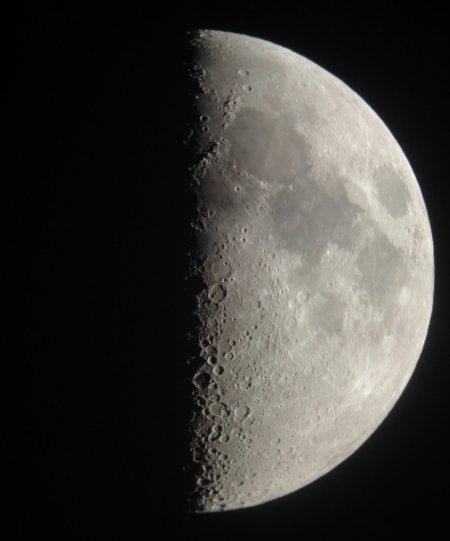
8
This moon is eight days old. It's a now waxing gibbous. This photo was shot through the 8" reflector. The photo was taken at 10:23 pm EDT on June 18th, 2002. An interesting feature this night is The Straight Wall. It appears as a thin dark line. It's about 70 miles long. It's actually a fault line formed from a moonquake in the ancient past. The Apennine Mountains are in full sunlight now. Above the Apennines, look for the Lunar Alps and the Alpine Valley. Moon's age: 8 days 2 hours 35 minutes.
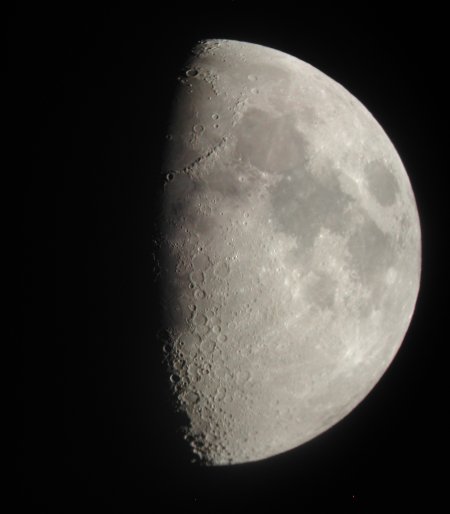
9
This moon is nine days old. Another waxing gibbous moon. This photo was from the 8" f/6 scope. The photo was taken at 10:44 pm EDT on June 19th, 2002. A stunning feature tonight is the crater Copernicus. Copernicus is 60 miles in diameter and 12,600 feet deep. Copernicus is a relatively young crater. It stands out so well because it's surrounded by a smooth dark plain. Above and to the left of Copernicus, the Carpathian Mountains are coming into view. Some of the peaks in this range are 6600 feet high. South of Copernicus is the faint crater Fra Mauro. Apollo 14 landed just north of this crater on January 31st, 1971. Moon's age: 9 days 2 hours 56 minutes.
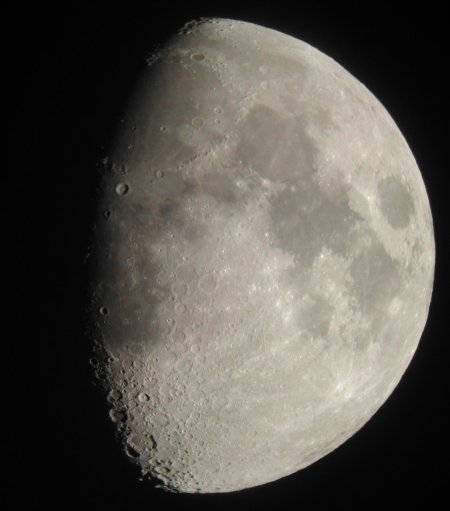
10
This moon is ten days old. The photo was taken at 10:30 pm EDT on June 20th, 2002 with the 8" telescope. Sinus Iridum also called the Bay of Rainbows, is visible near the north part of the terminator. The Jura Mountains ring the western edge of the Bay of Rainbows. The 6600 foot tall Straight Range is to the bay's northeast. Northwest of the crater Tycho is the Marsh of Diseases! Of course, the marshes, bays and seas on the moon don't contain any water. They are filled with lava that flowed across the moon and filled the lower areas of the moon billions of years ago. Now they are just dry smooth plains. Moon's age: 10 days 2 hours 42 minutes.
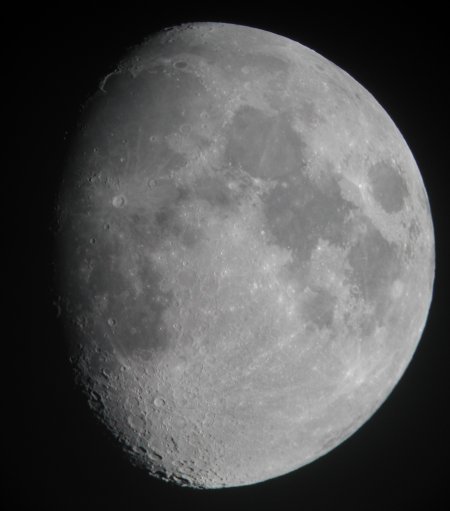
11
The eleven day moon. Oceanus Procellarum or the Ocean of Storms is now in view on the western side of the disk. The rays are becoming more noticeable. Rays are the spoke like lines radiating from several of the prominent craters. The rays are formed by the debris blasted out of the crater when it was formed by the impact of a meteorite. Tycho has the best ray system of any lunar crater. This photo was taken on June 21st 2002 at 11:35 pm EDT with the 8" scope. Moon's age: 11 days 3 hours 47 minutes.
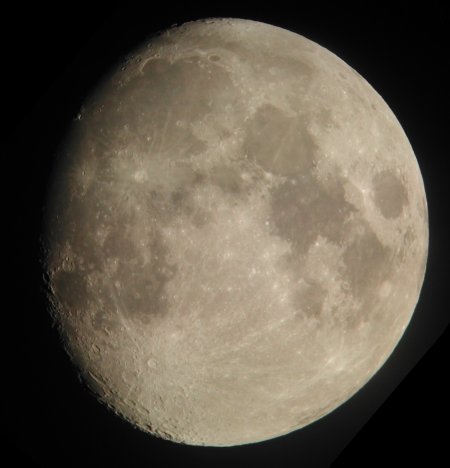
12
This moon is twelve days old. The date of this shot is June 23, 2002 12:47 am EDT. The terminator is still just barely visible along the western limb of the moon. The moon is not quite full. Full moon will take place 29 hours after this moment. The crater Billy is interesting. It's smooth floor is one of the darkest stained spots on the moon. The crater Wargentin has the nickname "The Thin Cheese" due to its appearance to a thin block of cheese. Wargentin is a crater that has filled up with lava. The floor of this crater is 1400 feet above the surrounding area. Moon's age: 12 days 4 hours 59 minutes.
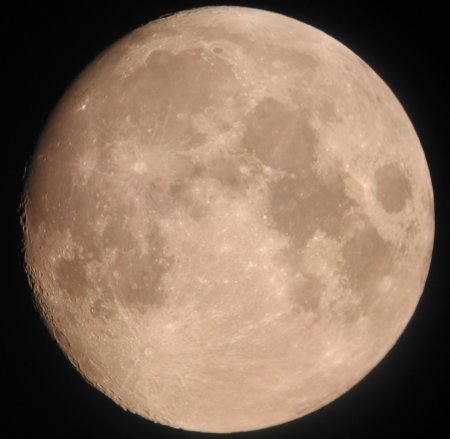
13
This is almost a full moon. The photo was taken 16 hours and 19 minutes before the exact moment of full. The photo was shot at 1:25 AM, EDT on June 24th 2002. With a good imagination, you might be able to see the "Rabbit in the Moon", or maybe the "Man in the Moon". Some people can see the "Lady in the Moon". For centuries, people have looked at the light and dark areas of the moon and imagined all sorts of things in the moon. What do you see?
Near the west limb of the moon are two very small craters, 10 and 8 miles in diameters. These little dots are the craters Galileo and Galileo A, two of the smallest named craters on the moon. These were named for Galileo Galilei, the Italian astronomer & physicist who lived from 1564 to 1642. Galileo was the first astronomer to aim a telescope at the moon and the first to see any of its craters and mountains. Moon's age: 13 days 5 hours 37 minutes.
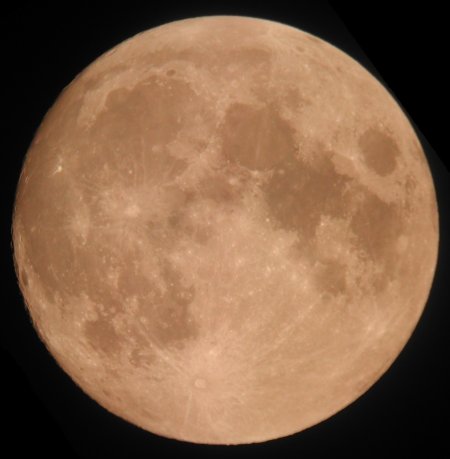
Lunar Eclipse
This is a full moon. The photo was taken during one of the rare times that the
full moon passes through the Earth's shadow. Sunlight that refracts or bends through the Earth's atmosphere gives an eclipsed moon a reddish look. Usually the full moon passes above or below shadow because the moon's orbit is tilted five degrees from the Earth's orbit around the Sun. It took the moon 23 minutes to pass through the umbra on this eclipse. The umbra is the inner, darker part of the Earth's shadow.
The photo was shot at 8:30 PM, EST on November 8th 2003. Moon's age: 14 days 12 hours 38 minutes.
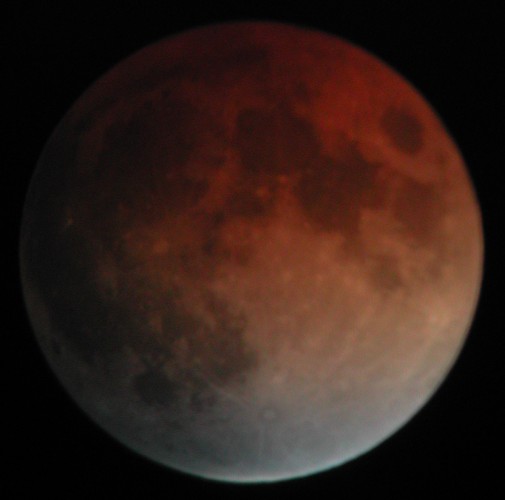
New to First Quarter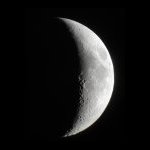
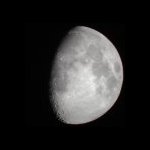 First Quarter to Full
First Quarter to Full
Full to Last Quarter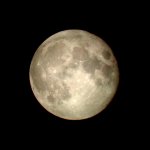
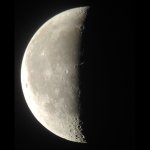 Last Quarter to New
Last Quarter to New
Photos by:
John French
Planetarium Production Coordinator
Abrams Planetarium
Michigan State University
East Lansing, Michigan, USA
Index Page









 First Quarter to Full
First Quarter to Full
 Last Quarter to New
Last Quarter to New